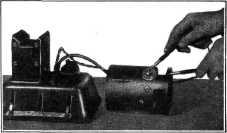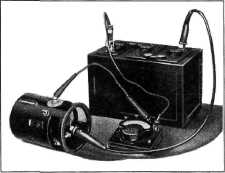1942 - 1947 CHEVROLET SHOP MANUAL
Section 12 - Electrical System
|
|
|||
|
12-16
|
|||
|
|
|||
|
terminal, disconnect
condenser and clean the contact points of both the current and
voltage regulator as explained under the heading "Cleaning Contact
Points."
GENERATOR OVERHAUL
Disconnect the field
and positive wires from the generator. Remove the generator brace nut,
fan belt and bracket bolts, then remove the generator from the engine.
Place the generator in
a bench vise, use the vise as a holding fixture only, being careful
not to pinch the generator frame. Remove the generator pulley. Remove
the commutator cover band, brush lead machine screws, through bolts
and commutator end frame assembly from the generator.
Remove the drive end
frame and armature assembly. Remove the drive end bearing inside
retainer plate, drive end bearing outside space collar and felt
washer from the armature shaft. The drive end bearing should then be
removed from the end of the armature shaft. Remove the drive end
bearing inside spacer washers, retainer plate and gasket.
With the generator
completely disassembled, Fig. 30, wash all parts in clean gasoline or
cleaning solvent.
TESTING GENERATOR
PARTS Field Coil Test for Continuous Circuit
Place the test prods
on the field coil leads as shown in Fig. 31. If the test lamp lights,
the field
|
lamp lights, field
coils are grounded and should be replaced. If the test lamp does not
light, field coils are OK.
|
||
 |
|||
|
Fig. 32-Field Coil Test for Ground
Field Coil Balancing Test
Slide the insulation
off the soldered connection between the two field coils. This test is
made with a battery, an ammeter and two leads. Place one test lead on
the soldered connection and the other on one end of the field coil,
Fig. 33. Take a reading
|
|||
 |
|||
 |
|||
|
Fig. 33-Fie!d Coil Balancing Test
on the ammeter. Remove
the lead from the end of the field coil and place it on the end of the
other field coil and take a reading. If one field coil draws more
current than the other, there is an internal short in the field coil
and the coil that draws the most current should be replaced.
Brush Lead to
Generator Positive Terminal Test for Continuous Circuit
Place test prods, one
on end of wire and the other on the terminal as shown in Fig 34. If
the test lamp lights, the wire is OK. If test lamp does not light, the
wire is open circuited and should be replaced.
|
|||
|
Fig. 31-Field Coil Test for Continuous Circuit
coils are OK. If the
test lamp does not light, the field coils are open-circuited and
should be replaced.
Field Coil Test for Ground
Place test prod
leads, one to the ground and the
other to field coil terminal, Fig. 32. If the test
|
|||
|
|
|||